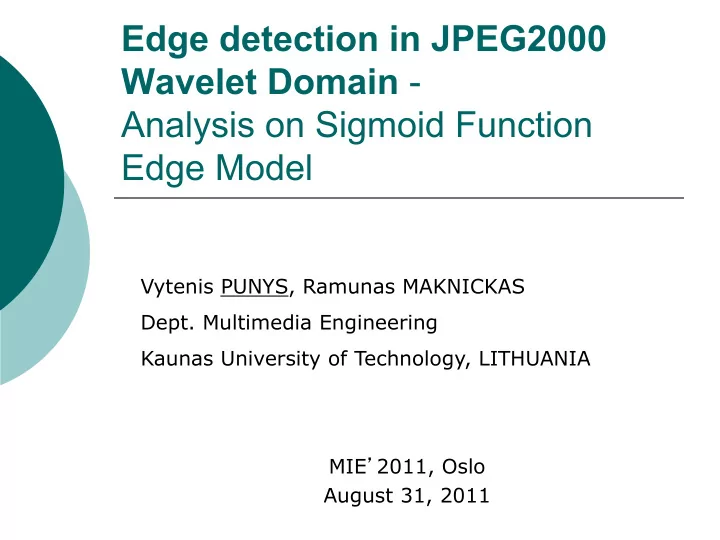

Edge detection in JPEG2000 Wavelet Domain - Analysis on Sigmoid Function Edge Model Vytenis PUNYS, Ramunas MAKNICKAS Dept. Multimedia Engineering Kaunas University of Technology, LITHUANIA MIE ’ 2011, Oslo August 31, 2011
Whole Slide Imaging – dimensions & amount of data ¡ Typical: 20mm x 15mm @ .5 µ pp ( “ 20X ” ) = 40,000 x 30,000 pixels = 1.2Gp = 3.6GB (uncompressed) 20mm x 15mm @ .25 µ pp ( “ 40X ” ) = 80,000 x 60,000 pixels = 4.8Gp = 14.4GB (uncompressed) ¡ Extreme: 50mm x 25mm @ .1 µ pp ( “ 100X ” ) = 500,000 x 250,000 pixels = 125Gp = 375GB (uncompressed) l x 10 Z-planes => 3.75TB V.Punys, R.Maknickas (KTU, LT) MIE ’ 2011, Oslo
Automatical Scanning Systems ¡ 384 glass slides, 2-4 min./slide (20x-40x), 1 z-plane ¡ 20x: 69.1 Gbyte / 12.8 hours 40x: 276.5 Gbyte / 25.6 hours @ JPEG2000 compression factor 1:20 V.Punys, R.Maknickas (KTU, LT) MIE ’ 2011, Oslo
Hierarchical Image Data Organisation Image Size( Image1 ) Size( Image2 ) 0.56 GByte 23.8 GByte Label 539 x 507 Macro 1280 x 446 Thumbnail 1024 x 641 839 x 768 Intermediate 1 3247 x 2033 2 912 x 2 665 Intermediate 2 6 494 x 4 066 5 824 x 5 331 Hi-Res1 (20x/10x) 25 976 x 16 264 23 298 x 21 324 Hi-Res2 (40x) 93 194 x 85 298 V.Punys, R.Maknickas (KTU, LT) MIE ’ 2011, Oslo
Research objective: quantification without image decompression ¡ What could be detected in compressed image data structures (wavelet domain) using the bi- orthogonal wavelets defined in the JPEG2000 standard for lossless (CDF 5/3) and lossy (CDF 9/7) compression. ¡ The parameters of detected objects (e.g. edges, their height and width) might be used for automatic cell quantification. V.Punys, R.Maknickas (KTU, LT) MIE ’ 2011, Oslo
Example of Microscopy Image (part of it) V.Punys, R.Maknickas (KTU, LT) MIE ’ 2011, Oslo
Wavelet coefficients (mapped to greyscale) V.Punys, R.Maknickas (KTU, LT) MIE ’ 2011, Oslo
Wavelet coefficients stored in JPEG 2000 format V.Punys, R.Maknickas (KTU, LT) MIE ’ 2011, Oslo
Wavelet coefficients “carry” information about signal magnitude and location … Issues: ¡ Wavelets: compression / detection? ¡ DWT – de-correlation of information l DWT coefficients “shifted” in space l DWT coefficients (value) depend on edge magnitude and position ¡ Detection of areas or edges? ¡ JPEG 2000 process > DWT: l Dyadic decomposition l Quantification of coefficients V.Punys, R.Maknickas (KTU, LT) MIE ’ 2011, Oslo
b f ( x , a , b ) , c 2 ln( 2 3 ), a 0 , Edge model – = = − > cx 1 e a + a a sigmoid function f ' ' ' ( , a , b ) f ' ' ' ( , a , b ) 0 . − = = 2 2 ¡ Edge height a ¡ Edge width b ¡ Edge position c (within the limits of decomposition) V.Punys, R.Maknickas (KTU, LT) MIE ’ 2011, Oslo
Back from wavelet coefficients to signal height and width ¡ Method 1: calculates parameters a and b of all suitable edges, whose wavelet maximum coefficients at analysed scales are equal to given w . The result is the set of ranges [b 1 ,b 2 ] of width for every height a of an edge. ¡ Method 2 calculates detectable height intervals [a 1 ,a 2 ] at various widths b of an edge. V.Punys, R.Maknickas (KTU, LT) MIE ’ 2011, Oslo
Modelling of edge detection M1: a=50 M2: a=150 V.Punys, R.Maknickas (KTU, LT) MIE ’ 2011, Oslo
Number of “ detected ” edge heights V.Punys, R.Maknickas (KTU, LT) MIE ’ 2011, Oslo
Results (1/2) ¡ Achieved results are encouraging to continue the research of edge detection in wavelet domain. ¡ Analysis showed different and unambiguous correspondence of edge parameter vectors to wavelet coefficients. ¡ Variability of detected edge width for any height does not exceed 0.5 pixel size for edges wider than 3 pixels. V.Punys, R.Maknickas (KTU, LT) MIE ’ 2011, Oslo
Results (2/2) ¡ M1 (“height first”) is more suitable for lossy compressed images, and M2 (“width first”) – for lossless compressed ones. ¡ Naturally, detection results in lossless compressed images are better than in lossy images, except the case when height of an object exceeds 150 – then the M1 is more accurate for height detection in lossy compressed images. V.Punys, R.Maknickas (KTU, LT) MIE ’ 2011, Oslo
Thank you for your attention Any questions ? ? Vytenis . Punys @ KTU . LT V.Punys, R.Maknickas (KTU, LT) MIE ’ 2011, Oslo
Recommend
More recommend